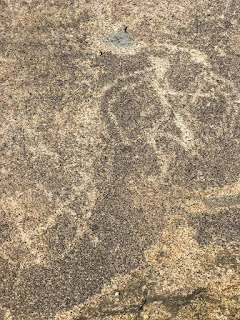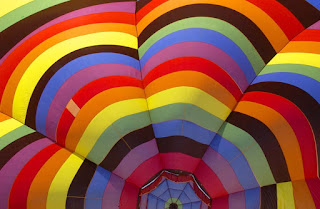Petroglyphs, Graffiti, and the inscrutability of public art
Donner Pass, a few miles west of Truckee, California, contains an area of well-preserved Indian petroglyphs. Petroglyphs are carved art created by cutting into the surface of rock. Archaeologists have found petroglyphs in many remote areas of the Sierra, often in places like the flat granite at Donner summit. This pass has been a trade route for a long time; the petroglyphs are thought to be two to three thousand years old.
 |
| Petroglyph at Donner Pass (c) John Robison 2018 |
The marker at the Donner petroglyphs is titled, “Sacred Symbols from Ancient Times,” but I’m not sure what evidence we have that the carvings were sacred beyond modern interpretation. We know very little about the context of these artworks. Were they trailside art that early people walked past as they followed a track over the mountain? Or were they carved in a special place, off the main trail?
Back in the day, the petroglyphs may have been painted or enhanced to be more visible.
A few hundred yards uphill you can see the tunnels that carried the first transcontinental railroad over the Sierra. The tunnels were cut in the 1860s, and augmented by wooden snow sheds to shelter the tracks from snow. The wooden sheds were vulnerable to fire and avalanche, and they were replaced by concrete structures in the 1950s.
A few hundred yards uphill you can see the tunnels that carried the first transcontinental railroad over the Sierra. The tunnels were cut in the 1860s, and augmented by wooden snow sheds to shelter the tracks from snow. The wooden sheds were vulnerable to fire and avalanche, and they were replaced by concrete structures in the 1950s.
 |
| Donner Pass - petroglyphs on flat granite in foreground, tunnels and snow sheds above and behind |
Walking into the train tunnels the first thing you see is the art adorning the walls. The tunnels are protected from rain and snow, and they provide miles and miles of concrete and stone canvas for today’s artists. Are those sacred art?
In many places, in the tunnels, quality artworks lie next to or even underneath rougher drawings, symbols, and written messages. What are the messages in the modern art? As with the petroglyphs, no one knows.
When we call outdoor art graffiti we often use the term as if it’s not art at all. Graffiti is to many a form of vandalism. Some who paint it may think that way, but others see it as a serious form of art, and they see themselves as serious artists. In some cases graffiti artists explain the thinking behind their creations but more often they are anonymous, and the view is left to draw his or her own conclusions.
It’s reasonable to think that much wall art is serious, and sacred might be a proper term for some of it. Other wall paintings are malicious; slashing or covering earlier works out of jealously, anger, or emotions we cannot fathom. Some is whimsical or notational, like“Kilroy was here, 2015,” and its like.
In cities some street art contains gang symbols and messages. Art that appears inscrutable to the general public (myself included) may have a clear meaning to a smaller group of initiated. Something similar may have been the case when the petroglyphs were carved, too.
Gangs over-write each other's symbols, but that is far from the only reason people write over existing art. Some simply want space for their creation. Others are jealous. Some of the notion of cleaning up "non-approved" art with something else. If we cannot understand the dynamics of graffiti now, how can we possibly understand the dynamics of 2,000BC?
Gangs over-write each other's symbols, but that is far from the only reason people write over existing art. Some simply want space for their creation. Others are jealous. Some of the notion of cleaning up "non-approved" art with something else. If we cannot understand the dynamics of graffiti now, how can we possibly understand the dynamics of 2,000BC?
Most of the modern day tunnel art will be gone 2,000 years from now, but some will probably survive. When the petroglyphs are contrasted with the graffiti of today – lining a modern railroad trade route – we may wonder if they were the outdoor art of that era, lining the trade paths of that day. Perhaps what we see is just a fraction of what was once there, and the reason the symbols seem jumbled and indecipherable is that the art was created by many people with many goals and intentions, and there was no coherent meaning.
We tend to interpret arrays of art (petroglyphs) or arrays of ruins (towns) as if there was a common purpose or an overall guiding theme. As today’s graffiti makes clear, that is not always the case today and there’s no reason to think the street art of times past was any different.
If an archaeologist of the future were to try and understand our civilization from the symbols in the Donner Pass tunnels, what would they conclude? The train tracks have been removed from the tunnels, so their overall purpose might not be apparent to a later observer. Would a future archaeologist assume a purposeful relationship between the tunnel and the paintings?
Recently some scientists have looked at the style of cave paintings in Europe and suggested the artists may have been autistic. We could ask the same about today’s graffiti artists. How many of them may be autistic? The scientists found parallels between some cave art and the drawings style of known autistic artists today. The same parallels may be found in contemporary graffiti, just as other graffiti is of different style.
It’s interesting to think that autistic people may have been creating art for tens of thousands of years. And non-autistic people have been doing it just as long. Looking at the jumble of styles on Donner Pass today it’s clear the two groups co-exist now, and the evidence of European caves suggest the same situation prevailed in the distant past.
If today’s graffiti art is anonymous, yesterdays is even more so. In some cases, modern art comes with readable messages, but all too often its meaning is in the mind of the viewer, and we can never know if our interpretation bears any similarity to what was in the creator’s mind.
Some things can never be understood.
(c) 2018 John Elder Robison
The opinions expressed here are his own. There is no warranty expressed or implied. While reading this essay will give you food for thought, actually printing and eating it may make you sick.


















.jpeg)



Comments